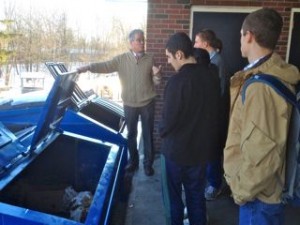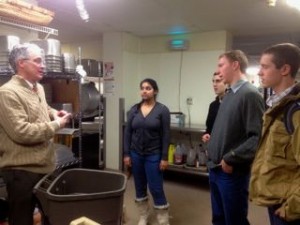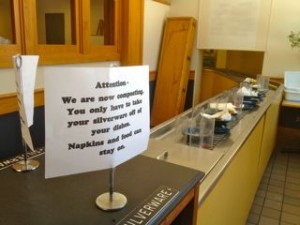 Kevin Martin pushed back the lid on the giant blue dumpster and stepped aside, letting a handful of students peer at a small mound of lemon rinds, lettuce leaves, broken eggshells, and brown paper bags.
Kevin Martin pushed back the lid on the giant blue dumpster and stepped aside, letting a handful of students peer at a small mound of lemon rinds, lettuce leaves, broken eggshells, and brown paper bags.
“All of this is generated from the dining hall. It doesn’t come from anywhere else on campus,” said Martin, The Williston Northampton School’s director of dining services.
“Wow! That’s great!” exclaimed one of the students.
The students, members of the school’s Sustainable Life Club, were touring the school’s new compost system, which included the dumpster—a large example of the reduce, reuse, recycle motto they try to embody.
Although school officials have considered composting the waste from the dining hall for several years, it took a final push from these students to make the effort a reality. The new compost bin was installed in early January; on a cold Monday, club members admired the squishy results of their hard work.
The idea of collecting compost on a larger scale first occurred to Nick Pattison ’14 while he was working with the school’s community garden last year. The garden has two compost bins, which garden club members fill with prep scraps from the dining hall.
“I’ve always wanted to bring more of the students inside the composting system,” Pattison said. “But our little composting unit over there is much too small for the amount of food we throw away and all the waste we generate in the dining hall.”
Earlier this year, Pattison helped form the Sustainable Life Club (also known as the Green Team) and also began a small composting project to bring a small bin from 194 Main, the dorm he proctors, to the garden. After meeting with Martin and talking over priorities with club members, Pattison also wrote an editorial in The Willistonian student newspaper, advocating a larger-scale composting route.
 “I brought it home to Williston, relating it to the dining hall, and how much waste we have,” Pattison said. “I wasn’t quite sure if it would go through. That’s the great part of it, you have nothing to lose, so you might as well just ask.”
“I brought it home to Williston, relating it to the dining hall, and how much waste we have,” Pattison said. “I wasn’t quite sure if it would go through. That’s the great part of it, you have nothing to lose, so you might as well just ask.”
Williston staff had looked into large scale composting before, including a trip to Springfield College to examine the operation there, but ran up against logistical and budgetary roadblocks. At the time, hauling the compost away was too expensive. Adding another dumpster to the multiple bins in the dining hall parking lot would have required an extension to the loading dock and was simply not practical, said Jeff Tannatt, director of the physical plant.
Then Williston switched to single-stream recycling. What had been separate dumpsters for bottles, cans, paper and cardboard became a single bin, Tannatt said.
“I am a huge recycler and have kind of been pushing the students to pick up this cause, because their voice is heard on these things,” Tannatt wrote in an email. “This is a significant expense for us and my desire to do this because it is good and right is often offset by a need to control and balance budgets.”
 With the Sustainable Life Club behind the project, Tannatt and Martin again broached the subject to see if they could make dining hall compost a reality. Over break, Tannatt contracted through Allied/Republic Waste Services for a compost dumpster.
With the Sustainable Life Club behind the project, Tannatt and Martin again broached the subject to see if they could make dining hall compost a reality. Over break, Tannatt contracted through Allied/Republic Waste Services for a compost dumpster.
He estimates that the dining hall will generate around eight cubic yards of compost per week—food that previously went down the garbage disposal, plus napkins, cardboard, and wooden crates. Cardboard and napkins are encouraged as the paper products soak up liquid in the bin.
The compost dumpster adds $800 per month to the school’s trash expense, but Tannatt said he expects to see less in the trash and recycling bins. He also expects to see a savings on the water side, now that the dining hall’s garbage disposal will not be needed. When it’s running, the disposal uses around seven gallons of water per minute (420 gallons per meal and 1,260 gallons a day). The grease that builds up in the disposal throughout the year will also almost entirely disappear.
“This is going to be somewhat of a learning process for us,” Tannatt said. “We are ahead of many others in starting this program so there is not a great knowledge base to work from. “
There has also been a compost learning curve on the dining hall staff side, said Martin. To help with the process, he placed compost buckets around the kitchen and hung posters indicating what could be composted. The big blue bin itself has been marked with notices about the compost; other signs let diners know to leave their scraps and napkins on their plates.
“I think it’s just a matter of people getting used to it,” Martin said. ”It’ll take some training—like when we got rid of the trays some years back—but I think once people get used to it, it’ll be second nature.”
To cut back on waste further, Martin has started looking into dining hall changes such as buying oyster crackers in bulk, rather than in individual packages.
“We’re trying to get as much stuff that can’t be composted out of here,” he said. “So we’re changing packaging on the food we purchase so more food can go into the compost.”
Martin said that there has been only one issue he’s noticed since the compost bin was installed in early January.
“The only problem is that the squirrels like it,” he said. “As long as there are no bears around, then we’re all set.”


Talk about a team making things happen: Kevin, Jeff and most importantly Nick and the Green Team! Congratulations to you all. I will report your good works to the Board of Trustees this weekend and encourage them all to read the Blog. Happy composting!